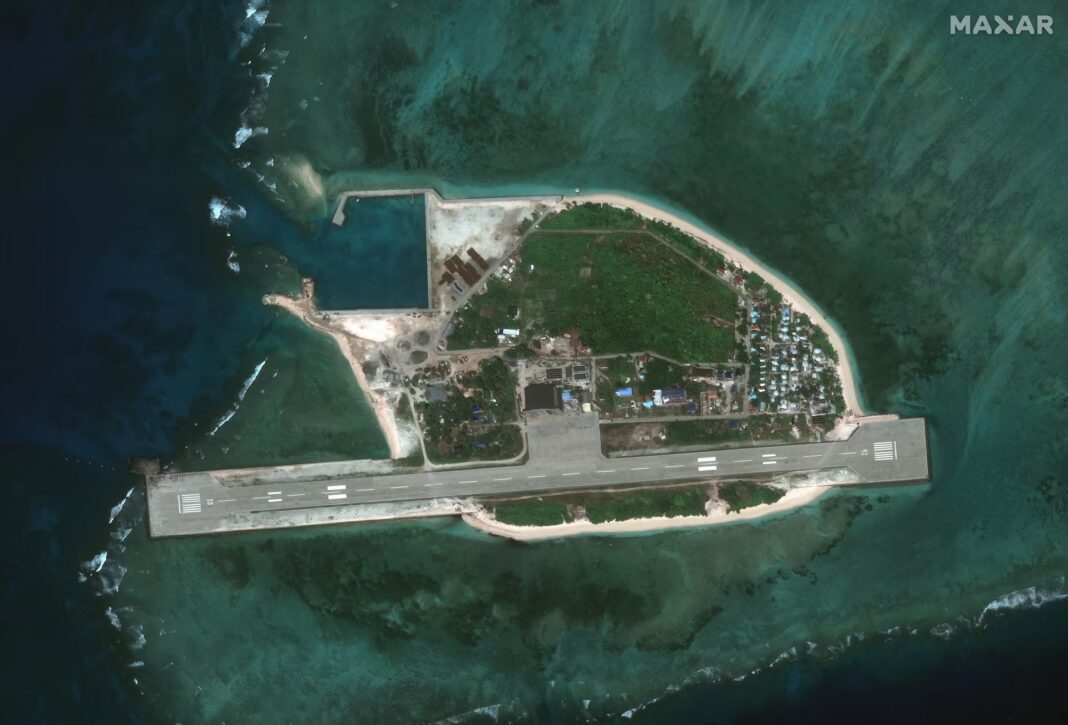Satellite Images Reveal Vessel Build-Up
Recent satellite images show a significant build-up of Chinese civilian vessels near Thitu Island, a vital outpost for the Philippines in the contested South China Sea. The images, captured by Maxar Technologies, revealed around 60 vessels clustered near the island, with some as close as two nautical miles. Many of these vessels appear to be Chinese-registered fishing boats. The images have drawn attention from regional observers and security analysts.
Thitu Island’s Strategic Importance
Known locally as Pag-Asa, Thitu Island is the Philippines’ largest and most strategically critical outpost in the South China Sea. The island serves as a hub for monitoring Chinese vessels and aircraft in this heavily trafficked region. The South China Sea is a vital waterway through which billions of dollars in goods are transported annually. It is a hotspot for disputes, with overlapping territorial claims from China, the Philippines, Vietnam, Malaysia, Brunei, and Taiwan.
Legal Backdrop and Previous Clashes
In 2016, the Permanent Court of Arbitration in The Hague ruled that China’s broad claims over the South China Sea had no legal basis under international law. Despite this, tensions have persisted, with recent clashes between Chinese and Philippine vessels near disputed areas such as Scarborough Shoal and Second Thomas Shoal. The build-up of Chinese vessels near Thitu Island adds another layer of complexity to this ongoing conflict.
Proximity to Chinese Naval Infrastructure
Thitu Island lies near Subi Reef, a Chinese-occupied area featuring a naval base and an airstrip. Subi Reef has often served as a staging point for Chinese maritime militia vessels. Experts suggest that the positioning of vessels near Thitu might be deliberate, potentially testing Manila’s response or aiming to delay ongoing construction on the island.
Philippines’ Response and Preparedness
Despite the visible presence of Chinese vessels, Philippine authorities have stated that the situation is under control. The military has emphasised the importance of maintaining a steady posture and avoiding overreaction. The Philippines is strengthening its presence and improving monitoring capabilities by enhancing Thitu Island’s infrastructure, including completing a new aircraft hangar soon.
International Reactions and Regional Concerns
Regional diplomats and analysts are closely observing the situation. The fact that many Chinese vessels had their transponders on, allowing them to be tracked, has raised questions about Beijing’s intentions. Some speculate that the move could be a strategic test of the Philippines’ resolve, particularly during a period of domestic political unrest in Manila.
Potential Delays in Development
Reports suggest that China might aim to slow down Philippine construction efforts on Thitu Island. These efforts are critical for bolstering the Philippines’ presence in the disputed waters. Improved facilities on the island would enhance the Philippines’ ability to monitor and respond to activities in the region.
A Broader Context of Maritime Tensions
The incident near Thitu Island is part of a larger pattern of maritime tensions in the South China Sea. China’s growing assertiveness has led to frequent confrontations with neighboring countries. These actions, often involving civilian vessels acting as maritime militia, blur the lines between civilian and military operations, complicating responses.
A Situation to Watch
The build-up near Thitu Island underscores the challenges of maintaining peace in the South China Sea. While the Philippine military remains cautious, the situation highlights the need for vigilance and international cooperation. With both nations seeking to assert their claims, the region’s future stability depends on continued dialogue and measured actions.

